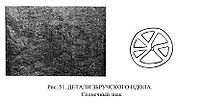- Cross
-
A cross is a geometrical figure consisting of two lines or bars perpendicular to each other, dividing one or two of the lines in half. The lines usually run vertically and horizontally; if they run obliquely, the design is technically termed a saltire, although the arms of a saltire need not meet at right angles.
The cross is one of the most ancient human symbols, and is used by many religions, such as Christianity. It is frequently a representation of the division of the world into four elements (Chevalier, 1997) or cardinal points, or alternately as the union of the concepts of divinity, the vertical line, and the world, the horizontal line (Koch, 1955).
Contents
Etymology
The word cross comes ultimately from Latin crux, a Roman torture device used for crucifixion, via Old Irish cros. The word was introduced to English in the 10th century as the term for the instrument of the torturous execution of Jesus as described in the New Testament, gradually replacing the earlier word rood.
History
It is not known when the first cross image was made; after circles, crosses are one of the first symbols drawn by children of all cultures. There are many cross-shaped incisions in European cult caves, dating back to the earliest stages of human cultural development in the stone age. Like other symbols from this period, their use continued in the Celtic and Germanic cultures in Europe. For example, celtic coins minted many centuries before the Christian era may have an entire side showing this type of cross, sometimes with the cardinal points marked by concave depressions in the same style as in stone age carvings. Other coins may be showing the cross held by a rider on a horse and springing a fern leaf, sometimes identified as a Tree of Life symbol.
As markings
Written crosses are used for many different purposes, particularly in mathematics.
- The Roman numeral for ten is X.
- In the Latin alphabet, the letter X and the minuscule form of t are crosses.
- The Chinese character for ten is 十 (see Chinese numerals).
- The dagger or obelus (†) is a cross
- The addition (or plus) sign (+) and the multiplication (or times) sign (×) are cross shapes.
- A cross is often used as a check mark because it can be clearer, easier to create with an ordinary pen or pencil, and less obscuring of any text or image that is already present than a large dot. It also allows marking a position more accurately than a large dot.
- A large cross through a text often means that it is wrong or should be considered deleted. A cross is also use stand-alone (✗) to denote rejection.
As emblems and symbols
Picture Cross Name Description 
Ancient Egyptian ankh Also known as the Egyptian Cross, the Key of the Nile, the Looped Tau Cross, and the Ansate Cross. It was an Ancient Egyptian symbol of life and fertility, predating the modern cross. Sometimes given a Latin name if it appears in specifically Christian contexts, such as the crux ansata ("handled cross").

Basque cross The lauburu. 
Christian cross Also known as the Latin cross or crux ordinaria. It is the most common symbol of Christianity, intended to represent the death of Jesus when he was crucified on the True Cross and his resurrection in the New Testament.

Coptic ankh The Coptic ankh is an adaptation of the Ancient Egyptian Ankh used by early Gnostic Christians in Egypt; compare Coptic cross.

Original Coptic Cross The original Coptic cross used by early Gnostic Christians in Egypt.
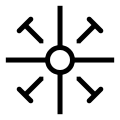
Coptic Cross A small circle from which emanate four arms of equal length, with angled T shapes in the corners, cross-pieces outward, representing the nails used in Jesus' crucifixion. This cross receives its name from Coptic Christianity, which centered on Alexandria, Egypt.
New Coptic Cross This new Coptic Cross is the cross currently used by the Coptic Orthodox Church and the Coptic Catholic Church of Alexandria. It evolved from the older Coptic Crosses depicted above. A gallery of Coptic Crosses can be found here.
# Double Cross Used by doctors and veterinarians as an introduction on medical prescriptions in Denmark and Norway. It is read "in nomine Dei" and followed by "rp": recipe [1]

Sun cross, Bolgar cross Also known as the Bolgar cross, Sunwheel, solar cross or Woden's cross. Used in Europe since the Neolithic era and by ancient and contemporary Native American culture to represent respectively Neopagan beliefs and the great Medicine Wheel of life. Was used by the Bulgarian Tzars (emperors) as a symbol of the Bulgarian Orthodox Church.

High cross Free-standing Celtic crosses commonly found in Ireland and to a lesser extent in Great Britain, very common in churches and graveyards.
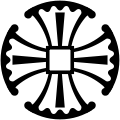
Canterbury cross Used in the Anglican Churches. It has four arms of equal length, each widening at the outer end in a hammer shape so that their rims nearly form a circle. Each arm bears a triangular panel incised with a triquetra symbolizing the Trinity. In the center of the cross is a small square. The Anglo-Saxon original, as a brooch, dates from c. 850 A.D. and was excavated in 1867 in Canterbury, England. A stone replica can be found in Canterbury Cathedral and in many other Anglican cathedrals around the world. [1]

Crucifix A representation of Jesus' body affixed to a cross. It is primarily used in the Catholic Church, Anglican, Lutheran, and Eastern Orthodox churches, and it emphasizes Christ's sacrifice— his death by crucifixion.

Greek cross Used especially by Eastern Orthodoxy and Early Christianity Also known as the crux immissa quadrata. Has all arms of equal length and not much longer than the width. Often the arms curve wider as they go out.

Red cross The earliest emblem of the Red Cross is a red Greek cross on a white background; it is often claimed to have been derived as the inverse of the Flag of Switzerland, which has a white Greek cross on a red background.

Serbian cross (Tetragrammatic cross) The motif of a cross between objects is perhaps derived from Constantine's labarum and has figured on Byzantine coins, since the 6th c. Later, the 4 symbols of the cross have been interpreted as flints or firestones, but also as the initials (letters β) of the imperial motto of the Palaiologos dynasty: King of Kings, Ruling Over Kings (Greek: βασιλεύς βασιλέων, βασιλεύων βασιλευόντων—Basileus Basileōn, Basileuōn Basileuontōn). The cross has been used by Serbian states and the Serbian Orthodox Church since the Middle Ages after Dušan the Mighty was crowned Emperor (Tsar) of the Serbs and Greeks (16 April 1345). Today it is the national, religious and ethnic symbol of Serbs and Serbia.


Florian cross Adopted as an emblem by the fire service, this cross is named for Saint Florian, the patron saint of Austria and firefighters. Although similar to the Maltese Cross and Cross pattée, it differs in having arms rounded outwards at the ends. Two different versions are included here; the one above is commonly found on fire service badges, patches, and emblems; the one below is typical of the St. Florian medallion or medal.

Eastern cross Used in the Eastern Orthodox Church. The top line is said to represent the headboard, and the bottom, slanted line represents the footrest, wrenched loose by Jesus' writhing in intense agony. It is raised to the left side, because that was the side of the righteous criminal who said to Jesus: "remember me when you come into your kingdom". This symbolises the victory of good over evil. The letters IC XC found at the end of the main arm of most Eastern Orthodox Crosses are a Christogram, representing the name of Jesus Christ (Greek: Ιησούς Χριστός). See also the Cross of Salem.

St. Brigid's Cross This cross is found throughout Ireland. It is told that Brigid, daughter of a pagan king, made the cross from reeds to be used as an instrument of conversion. However, Brigid's name is derived from Brigit (also spelled Brigid, Brìghde, Brìde, and Bríde), a Celtic Goddess of fire, poetry, and smithcraft, and today the cross is used to protect houses from fire. This is an example of the integration of religious traditions.
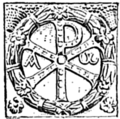
Chi-Rho Constantine I's emblem, the Chi-Rho (from the two Greek letters that make it up) is also known as the labarum or Christogram. Several variants exist.

Lorraine Cross Used in heraldry. It is similar to a patriarchal cross, but usually has one bar near the middle and one near the top, rather than having both near the top. Is part of the heraldic arms of Lorraine in eastern France. It was originally held to be a symbol of Joan of Arc, renowned for her perseverance against foreign invaders of France.

Marian Cross Included on the coat of arms of Pope John Paul II, the Marian Cross is a Catholic adaptation of the traditional Latin cross to emphasize Catholic devotion to Mary.
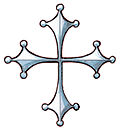
Pisan cross The coat of arms of the people of Pisa; now symbol of the Comune of Pisa.

Occitan cross The central figure in the coat of arms of the counts of Toulouse; now a symbol of Occitania as a whole.

Papal Cross The three cross-bars represent the Pope's triple role as Bishop of Rome, Patriarch of the West, and successor of St. Peter, Chief of the Apostles.

Patriarchal cross Similar to a traditional Christian cross, but with an additional, smaller crossbar above the main one meant to represent all the Orthodox Christian Archbishops and Patriarchs. In the Eastern Orthodox Church, this cross is sometimes seen with an additional, slanted bar near the foot of the cross (see Byzantine cross). This cross is similar to the Lorraine Cross, Caravaca Cross, and Salem Cross.

Celtic Cross Popular in British Isles in Roman Catholic, Anglican and Presbyterian denominations. Also called "St. Luke's Cross" by School of Theology (Episcopal) graduates that receive a cross upon graduation. 
Cross of Sacrifice A Latin cross with a superimposed sword, blade down. It is a symbol used by the Commonwealth War Graves Commission at the site of many war memorials.

Cross of Salem Also known as a pontifical cross because it is carried before the Pope, it is similar to a patriarchal cross, but with an additional crossbar below the main crossbar, equal in length to the upper crossbar. It is also similar to the Eastern Cross.

St. Nino's Cross Also known as a "Grapevine cross" and traditionally ascribed to Saint Nino, the 4th-century female baptizer of the Georgians, it is used as a symbol of the Georgian Orthodox Church.
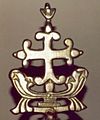
St. Thomas Cross Also known as a "Mar Thoma Cross" and traditionally ascribed to Saint Thomas, the Apostole of India, it is used as a symbol of the Syro Malabar Catholic Church and venerated by all Saint Thomas Christians denominations.[2]

St George's Cross (in Scandinavia) The definition of a St George's cross is, in Scandinavia, extended to also include a centred cross, normally red but not necessarily, with triangular arms that do not fill the square.[3] The example beside is the cross of the Swedish Order of Freemasons.

Saint Peter's Cross/Inverted Cross An upside-down Latin cross, based on a tradition that holds that Saint Peter was martyred by being crucified upside-down. Today it is often associated with anti-Christian or Satanic groups.

Tau Cross Also known as Saint Anthony's Cross, the Egyptian Cross and the crux commissa. It is shaped like the letter T. Francis of Assisi used it as his signature.

Thieves' Cross Also known as the Furka Cross. The fork, shaped like the letter Y. [2]

Mariner's Cross The Mariner's Cross is a stylized cross in the shape of an anchor. The Mariner's Cross is also referred to as St. Clement's Cross in reference to the way he was martyred.
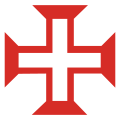
Order of Christ Cross Cross originally used by the Portuguese Order of Christ. Since then it has become a symbol of Portugal, used on the sails of the carracks during the Discoveries Era, and currently by the Madeira Autonomous Region of Portugal and the Portuguese Air Force.

Hands of God The Hands of God (Slavic: ręce boga) is a pre-Christian[citation needed] symbol in central Europe.

Neolithic cross, later adapted to form the Celtic Cross A sun cross with the arms of the cross extended beyond the perimeter of the circle. This symbol was adopted by many Christians, who often extended the lower arm in the manner of a Christian cross, creating what is now known as a Celtic cross. Some white nationalist and neo-fascist groups adopted this variation of the Celtic cross, made up of simple lines, without any of the ornamental complexity of traditional Celtic crosses. It is thought that this basic variation's minor resemblance to the swastika[citation needed] is the reason it has become popular in such circles. This variation was also used by the Zodiac killer at the scenes of his crimes.
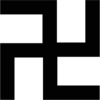
Swastika The swastika is an equilateral cross with its arms bent at right angles, in either right-facing (卐) form or its mirrored left-facing (卍) form.
Archaeological evidence of swastika-shaped ornaments dates from the Neolithic period. It occurs mainly in the modern day culture of India, sometimes as a geometrical motif and sometimes as a religious symbol. It remains widely used in Eastern and Dharmic religions such as Hinduism, Buddhism and Jainism. Though once commonly used all over much of the world without stigma, because of its right-facing variant's iconic usage in Nazi Germany, the symbol has become stigmatized in the Western world.

Macedonian Cross One of the symbols of the Macedonian Orthodox Church – Ohrid Archbishopric. It is also known by the name Veljusa cross (вељушки крст) because it was found in the monastery of Holy Mother of God in Veljusa.
In heraldry
These crosses are ones used primarily or exclusively in heraldry and do not necessarily have any special meanings commonly associated with them. Not all the crosses of heraldry and the crosses with commonly known contexts are listed below.
Picture Cross name Description 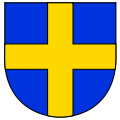
The cross as heraldic "ordinary" The basic heraldic cross (the default if there are no additional specifying words) has arms of roughly equal length, adapted to fit the particular shape of the shield, extending to the edges of the shield (or subdivision thereof)—as in the coat of the City of London.
A cross which does not extend to the edges of the shield is couped or humetty, in heraldic terminology, as in the coat, flag and badge of Geiger, Canada; it is shown with all its limbs of equal length and is also sometimes called a Greek cross.

Cross barbed Found in the coat of Umziginsi School, South Africa (see South Africa's Bureau of Heraldry); and in the coat of Upper Macungie Township, Lehigh County, Pennsylvania (see The Heraldic Register of America); also the coat of Tillie in Cornwall (cited in Parker's Glossary, s.v. Cross barby). The symbol --also called an arrow cross-- in green was the rallying symbol of the former Hungarian Nazi-style party.

Cross bottony A cross with the ends of the arms bottony (or botonny), i.e. shaped like a trefoil—and so it is sometimes called a cross trefly. It occurs counterchanged on the flag of Maryland; a saltire botonny can be seen in the coat and flag of the Village of New Maryland, New Brunswick; and a Latin cross trefly can be seen in the coat of Isidore Popowych.
In early armory it is not always distinguished from a cross crosslet.

Cross cercelée A cross recercely seems to be a cross moline parted or voided throughout—though it may be a cross moline very curly (Brooke-Little An heraldic alphabet, p 77).
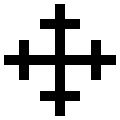
Cross crosslet A cross with the ends of each arm crossed. A prominent early example is in the arms of the Beauchamp earls of Warwick. In early armory it is not always distinguished from a cross bottony. A variant is the cross crosslet double crossed,[4] with two bars crossing each arm, as in the arms of Robert Willoughby, 1st Baron Willoughby de Broke(d.1502) sculpted on his tomb at Callington Church, Cornwall
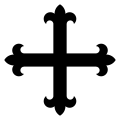
Cross fleury or flory A cross whose arms end in fleurs-de-lys – as in the coat of the Municipalité de la Paroisse de Saint-Philémon. In early armory it was not consistently distinguished from the cross patonce.
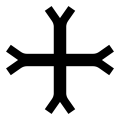
Cross fourchee One form of the heraldic cross fourchee (fourchée, fourchy) or cross fourche (meaning "forked"). An example is the South African Postal Association (South Africa's Bureau of Heraldry)
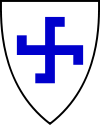
Fylfot Upright cross with truncated angled arms; essentially a variant of the swastika; uncommon, but can be found in the crest of Gordon of Hallhead (Scots Public Register volume 31, page20). Also known as a gammadion cross, consisting of four capital Greek letters Γ (gamma).
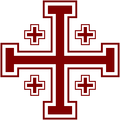
Jerusalem cross The symbol of the Crusader Kingdom of Jerusalem, which existed for almost two hundred years after the First Crusade; in the rendering at left, the large cross is shown slightly "potent", but that is not always the case. The four smaller crosses are said to symbolize either the four books of the Gospel or the four directions in which the Word of Christ spread from Jerusalem. Alternatively, all five crosses can symbolize the five wounds of Christ during the Passion. This symbol is used in the flag of Georgia. Also found in the coat of arms of the Papal Equestrian Order of the Holy Sepulchre of Jerusalem, Vatican City (matriculated in Scotland as "Argent; a Jerusalem cross cantoned between four crosses couped, gules"—Scots Public Register, volume 75, page 112)—to be seen at various EOHSJ websites; also in the Canadian coat of Robert Gerald Guest (Canadian Public Register Volume III, page 85).
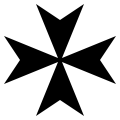
Maltese cross With arms which narrow towards the center, and are indented at the ends, also known as the eight-pointed cross (with no curved lines). Perhaps best known as a badge of the Order of Malta; whether connected with the Order or not, it is a common heraldic device—found in the coat of the London Borough of Hackney and the Canadian coat of Eric Lawrence Barry; as a "cross of eight points" to be found in the crest of Robert G. Loftus, Canada.
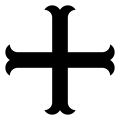
Cross moline In a cross moline, the ends of the arms are bifurcated, split and curved back, as found in the English coat of Kirkby Urban District Council and the Canadian coat of Charles Macdonald Lloyd Buchanan; surprisingly often to be found pierced, as shown in the online version of Guillim, section II chapter VII.
It is also called a cross ancré or anchory as in the arms of Rory Henry Grattan Fisher and of the Town of Dalmeny, Saskatchewan.

Cross patonce A cross patonce is more or less intermediate between a cross pattée and a cross flory (or fleury). The ends of its limbs are trifurcated into leaf shapes, and seems to come in two sorts: one where the limbs are the same width all along as in the coat of Godfrey McCance Gransden; and the other where the limbs gently widen from the centre (but do not curve) as in the coat of John Chiu (both of Canada). A mediaeval example is shown on the seal of William de Fortibus(d.1260)
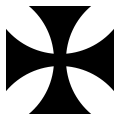
Cross pattée A cross pattee (pattée, patty), or formée (formy) has arms narrowing towards the centre, but with flat ends. It can be shown with curved inside edges as in the coats of Fr. Marc Edward Smith (Canada) and Lydney Town Council, England or the Iron Cross; but sometimes encountered with straight edges (triangular arms). The symbol was also used as the military aircraft roundel design for the former German Empire and the former Kingdom of Bulgaria.
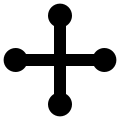
Cross pommee A cross pommee (pommée, pommy) has a round knob at the end of each arm, as in the coat of Penwith District Council, England.
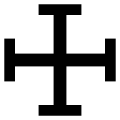
Cross potent This cross has a crossbar at the end of each of its arms. "Potent" is an old word for a crutch, and is used in heraldic terminology to describe a T shape. It is used by many, mostly Roman Catholic, Scouting and Guiding organisations in their logos and insignia. Found in the coat of Stevan Bradley Graeme Ralph and the badge of Fr. Mark Lowell Sargent (both Canada).

Cross quadrate A cross with a square at the intersection point (sometimes with a smaller relative size than shown in the illustration); found in the coats of Francesco Maestri (Canada) and Warwick District Council, England.
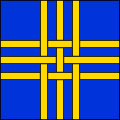
Cross triple parted and fretted A cross "parted and fretted" is divided and interlaced; if no number is specified, it has two strips in each direction. Found (triple parted) in the coat, flag and badge of the Greater Vancouver (British Columbia) Transportation Authority Police Service; and (double) in the coat of Croydon County Borough Council, England.

Cross voided A "cross voided throughout" has the central parts of the limbs cut with the colouring behind it showing through—as in the coat of the City of Lacombe, Alberta. The centre may be filled with another tincture as in the coat of the Town of Abbotsford, British Columbia.

Cross fitchy A cross fitchy has the lower limb pointed, as if to be fixed in the ground. Shown here is a cross crosslet fitchy, a very frequent charge in British and French armory, appearing in the arms of the House of Howard, the Marquess of Ailsa, the Earl Cathcart, Macpherson of Cluny, among many others. This is probably the most common fitched cross but others do exist, such as the crosses formy fitchy found between the antlers of the stag supporters of South Buckinghamshire District Council, England.
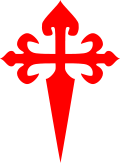
Cross of St James The Cross of St. James is similar to a cross flory fitchy, but is more sword-like. (The version shown on the left is the one used by the order of Santiago.) Found in the Scottish arms of Mulino from Venezuela (Scots Public Register volume 87, page 20) and in the coats of Santa Cruz de Tenerife, Spain; and Caracas, Venezuela; Santiago de Tete, Mozambique.

Cross erminée A cross erminée is a cross of four ermine-spots, with the heads meeting, sharing their spots. Historically borne by Hurston (Cheshire, England) and others[5]
There are numerous other variations on the cross in heraldry. See heraldry for background information.
James Parker's A Glossary of Terms Used in Heraldry (1894) is online, and contains much information about variants of crosses used in heraldry.
In flags
Several flags have crosses, including all the nations of Scandinavia, whose crosses are known as Scandinavian crosses, and many nations in the Southern Hemisphere, which incorporate the Southern Cross. The Flag of Switzerland since the 17th century has displayed an equilateral cross in a square (the only square flag of a sovereign state apart from the Flag of the Vatican City); the Red Cross emblem was based on the Swiss flag.
Sovereign state flags with crosses
-
Flag of Georgia -
Flag of Burundi -
Flag of Denmark -
Flag of Dominica -
Flag of Dominican Republic -
Flag of Finland -
Flag of Greece -
Flag of Iceland -
Flag of Jamaica -
Flag of Malta -
Flag of Portugal -
Flag of Norway -
Flag of Serbia -
Flag of Slovakia -
Flag of Sweden -
Flag of Switzerland -
Flag of Tonga -
Flag of United Kingdom
Other selected flags and arms with crosses
-
Flag of Scotland and San Andres -
Flag of Quebec -
Flag of the Navy, Italy -
Arms of Schwyz, Switzerland -
Flag of the Carabinieri gendarmerie, Italy -
Arms of Kreuzlingen, Switzerland -
Flag of Madeira Autonomous Region -
Flag of Portugal (1095) -
Southern cross appearing on a number of flags -
Flag of the President of Finland includes the Cross of Liberty, 3rd Class in the canton and the same like design is also found in presidential decorations, as the Crand Cross of the White Rose of Finland with the fir cross Collar
Other noteworthy crosses
Crux, or the Southern Cross, is a cross-shaped constellation in the Southern Hemisphere. It appears on the national flags of Australia, Brazil, New Zealand, Niue, Papua New Guinea and Samoa.
The tallest cross, at 152.4 metres high, is part of Francisco Franco's monumental "Valley of the Fallen", the Monumento Nacional de Santa Cruz del Valle de los Caidos in Spain.
A cross at the junction of Interstates 57 and 70 in Effingham, Illinois, is purportedly the tallest in the United States, at 198 feet (60.3 m) tall.
The tallest freestanding cross is located in St. Augustine, FL and stands 260 feet.
The tombs at Naqsh-e Rustam, Iran, made in the 5th century BC, are carved into the cliffside in the shape of a cross. They are known as the "Persian crosses".
See also
- Armenian memorial Cross-stone
- Christian cross
- Christianity
- Cleché
- Cross-ndj (hieroglyph)
- Cross and Crown
- Cross burning
- Crossroads (mythology)
- Crossbuck
- Crucifixion
References
Notes
- ^ Doppeltkors (Danish)
- ^ Nasrani.net
- ^ Nationalencyklopedin. "Georgskors", retrieved on 2010-08-12.
- ^ Terminology of Robson, Thomas, The British Herald
- ^ http://www.heraldsnet.org/saitou/parker/Jpglossc.htm#Cross
Sources
- Chevalier, Jean (1997). The Penguin Dictionary of Symbols. Penguin ISBN 0-14-051254-3.
- Drury, Nevill (1985). Dictionary of Mysticism and the Occult. Harper & Row. ISBN 0-06-062093-5.
- Koch, Rudolf (1955). The Book of Signs. Dover, NY. ISBN 0-486-20162-7.
- Webber, F. R. (1927, rev. 1938). Church Symbolism: an explanation of the more important symbols of the Old and New Testament, the primitive, the mediaeval and the modern church. Cleveland, OH. OCLC 236708.
- Cleché
External links
- The Christian Cross of Jesus Christ: Symbols of Christianity, Images, Designs and representations of it as objects of devotion
- Seiyaku.com, all Crosses
- Lutheransonline.com, variations of Crosses—images and meanings
- Nasrani.net, Indian Cross
- Freetattoodesigns.org, The Cross in Tattoo Art
Categories:- Cross symbols
- Christian iconography
- Christian symbols
- Christian terms
- Heraldic ordinaries
- Religious symbols
Wikimedia Foundation. 2010.


